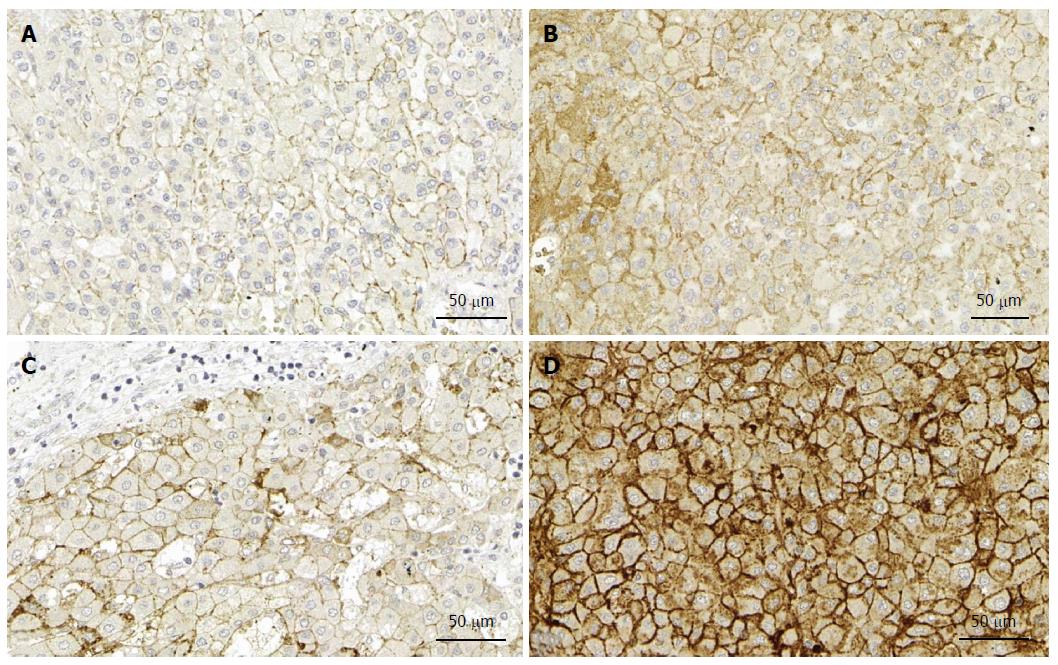Copyright
©The Author(s) 2016.
World J Gastroenterol. Jan 7, 2016; 22(1): 379-393
Published online Jan 7, 2016. doi: 10.3748/wjg.v22.i1.379
Published online Jan 7, 2016. doi: 10.3748/wjg.v22.i1.379
Figure 1 Expression of proteoglycans in normal and diseased liver.
Detection of heparan sulfate (HS4C3 antibody) in normal liver (A) and in liver cancer (B). In normal liver the reaction is localized mainly in the sinusoids, and delicate staining is visible on the surface of hepatocytes. In contrast, in hepatocellular carcinoma (HCC) amplified amounts of heparan sulfate (HS) are visible around the individual tumor cells, most likely representing the sugar component of cell surface HSPGs. Connective tissue surrounding the tumorous nests is also loaded with HS; C: Typical picture of glycosaminoglycan (GAG) on cellulose acetate electrophoresis. GAG isolated from normal liver (1), from peritumoral liver (2), from liver cancer (3), from normal liver after chondroitinase ABC digestion (4, 5). Bands from the bottom to the top: heparan sulfate, dermatan sulfate, chondroitin sulfate. Note that the majority of GAGs are HS in the normal and peritumoral liver, whereas CS dominates in HCC; D: Separation of proteoglycans of liver origin on PAGE. Liver surrounding colon cancer metastasis (1), healthy liver (2), liver from α1-antitrypsin deficiency (3), fibrolamellar carcinoma (4), peritumoral liver of FLC (5), HCC (6), and peritumoral liver of HCC (7). Artificial colorization emphasizes the difference between normal and diseased specimens.
Figure 2 Syndecan expression in the liver.
A: Expression of syndecan-1 in normal liver; B: Expression of syndecan-1 in liver cancer without cirrhosis; C: Expression of syndecan-1 in liver cirrhosis; D: Expression of syndecan-1 in liver cancer with cirrhosis. Note that only modest elevation of syndecan expression can be observed in cancer without cirrhosis, in contrast with the cancer specimen with cirrhosis. Immunopositivity in the cytoplasm of the latter indicates the impairment of transport to the cell surface. Immunohistochemistry on formalin fixed paraffin embedded specimens. (Primary antibody Dako MI 15).
Figure 3 Colocalization of perlecan and basic fibroblast growth factor in the capillaries of hepatocellular carcinoma.
A: Perlecan; B: Basic fibroblast growth factor (bFGF). Serial sections were prepared from paraffin embedded hepatocellular carcinoma specimens. Note the identical localization of perlecan and bFGF in the basement membrane of blood vessels marked by asterisks. (Primary antibodies are: mouse anti-perlecan AB: clone 7B5, Zymed Laboratories; goat anti-bFGF antibody, R&D systems).
- Citation: Baghy K, Tátrai P, Regős E, Kovalszky I. Proteoglycans in liver cancer. World J Gastroenterol 2016; 22(1): 379-393
- URL: https://www.wjgnet.com/1007-9327/full/v22/i1/379.htm
- DOI: https://dx.doi.org/10.3748/wjg.v22.i1.379











